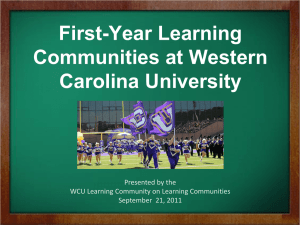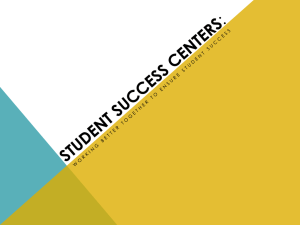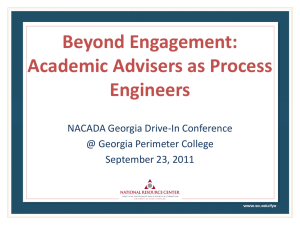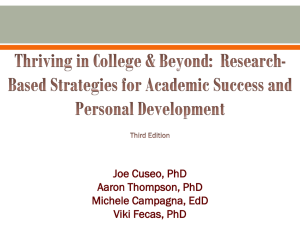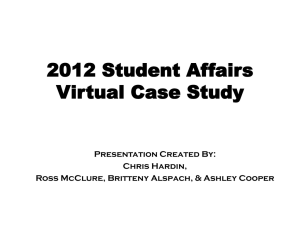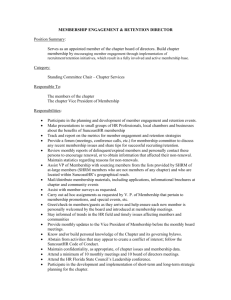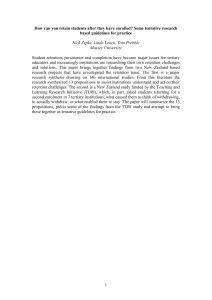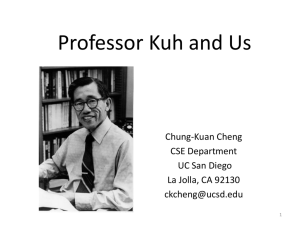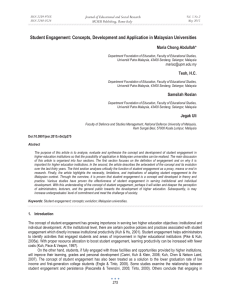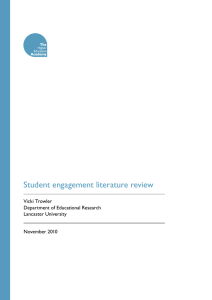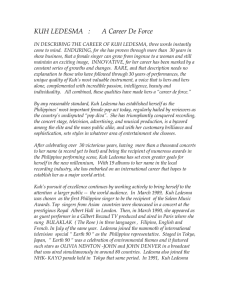FYE.CUSEO.SevenPowerfulProperties
advertisement
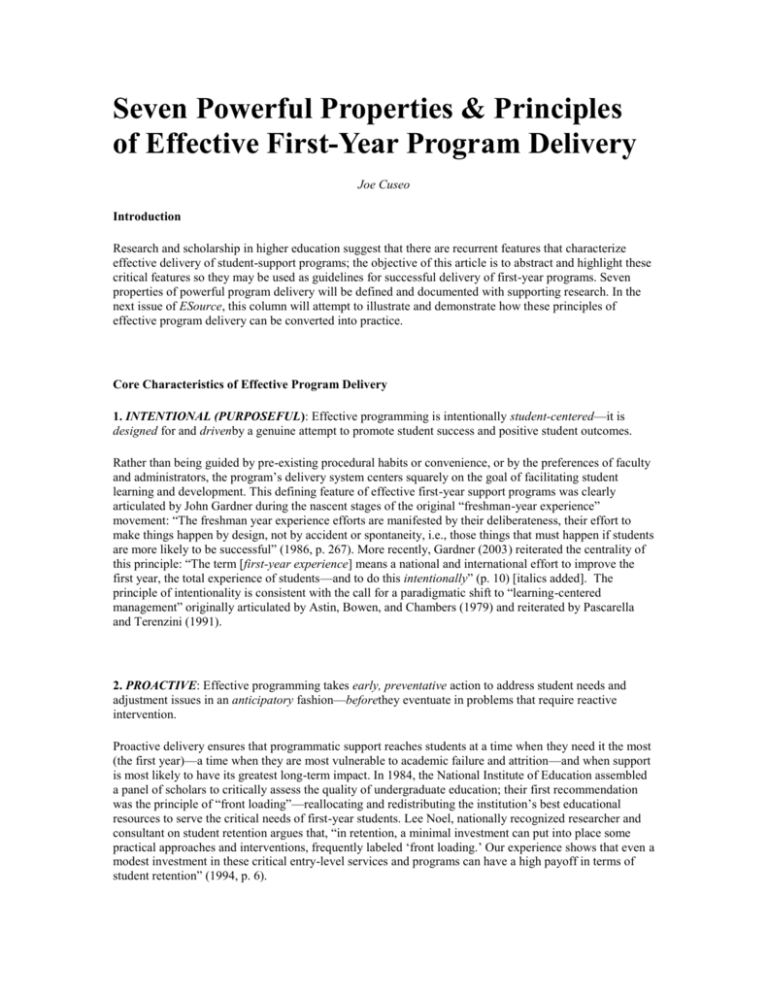
Seven Powerful Properties & Principles of Effective First-Year Program Delivery Joe Cuseo Introduction Research and scholarship in higher education suggest that there are recurrent features that characterize effective delivery of student-support programs; the objective of this article is to abstract and highlight these critical features so they may be used as guidelines for successful delivery of first-year programs. Seven properties of powerful program delivery will be defined and documented with supporting research. In the next issue of ESource, this column will attempt to illustrate and demonstrate how these principles of effective program delivery can be converted into practice. Core Characteristics of Effective Program Delivery 1. INTENTIONAL (PURPOSEFUL): Effective programming is intentionally student-centered—it is designed for and drivenby a genuine attempt to promote student success and positive student outcomes. Rather than being guided by pre-existing procedural habits or convenience, or by the preferences of faculty and administrators, the program’s delivery system centers squarely on the goal of facilitating student learning and development. This defining feature of effective first-year support programs was clearly articulated by John Gardner during the nascent stages of the original “freshman-year experience” movement: “The freshman year experience efforts are manifested by their deliberateness, their effort to make things happen by design, not by accident or spontaneity, i.e., those things that must happen if students are more likely to be successful” (1986, p. 267). More recently, Gardner (2003) reiterated the centrality of this principle: “The term [first-year experience] means a national and international effort to improve the first year, the total experience of students—and to do this intentionally” (p. 10) [italics added]. The principle of intentionality is consistent with the call for a paradigmatic shift to “learning-centered management” originally articulated by Astin, Bowen, and Chambers (1979) and reiterated by Pascarella and Terenzini (1991). 2. PROACTIVE: Effective programming takes early, preventative action to address student needs and adjustment issues in an anticipatory fashion—beforethey eventuate in problems that require reactive intervention. Proactive delivery ensures that programmatic support reaches students at a time when they need it the most (the first year)—a time when they are most vulnerable to academic failure and attrition—and when support is most likely to have its greatest long-term impact. In 1984, the National Institute of Education assembled a panel of scholars to critically assess the quality of undergraduate education; their first recommendation was the principle of “front loading”—reallocating and redistributing the institution’s best educational resources to serve the critical needs of first-year students. Lee Noel, nationally recognized researcher and consultant on student retention argues that, “in retention, a minimal investment can put into place some practical approaches and interventions, frequently labeled ‘front loading.’ Our experience shows that even a modest investment in these critical entry-level services and programs can have a high payoff in terms of student retention” (1994, p. 6). 3. INTRUSIVE: Effective programming initiates institutional action by reaching out to students and bringing or delivering support tothem, rather than passively waiting for students to seek it out on their own. Ender, Winston, & Miller (1984) captured the gist of this principle almost 20 years ago when they forcefully stated that “it is totally unrealistic to expect students to take full advantage of the intellectual and personal development opportunities [on campus] without some assistance from the institution” (p. 12). The retention and academic success of underrepresented and first-generation students, in particular, are seriously undercut by institutional over-reliance on student-initiated involvement in campus-support programs (Rendon, 1994; Terenzini, et al., 1994). Both student effort and institutional effort are required to promote students success, but short shrift has been paid to the latter form of effort in higher education (Kuh, Schuh, Whitt, & Associates, 1991). Intrusive program delivery may be viewed as an intensive investment of institutional effort to ensure that programmatic support reaches all (or the vast majority of) students who will benefit from it, not just those students who are assertive or confident enough to take advantage of it. 4. DIVERSIFIED: Effective programming is tailored or customized to meet the distinctive needs of students from different subpopulations, and students at different stagesof their college experience. Diversified program delivery recognizes the reality that the undergraduate student body is a heterogeneous entity comprised of different subgroups whose needs may vary, depending on their background experiences prior to college and their level of experience with college. The program acknowledges students’ unique characteristics, such as their age, gender, race or ethnicity, and is delivered in a timely manner that addresses the changing needs and different developmental challenges experienced by students at different stagesof their college experience (first term, second term, sophomore year, etc.). No single, formulaic response meets the needs of all students; an effective program is responsive to differences among learners and displays programmatic flexibility (Tierney, 2000). As Tinto (1993) notes, “Successful institutional action entails the fine-tuning of programming to the specific needs of differing students” (p. 180). 5. COLLABORATIVE: Effective programming involves cooperative partnerships between and among different organizational units of the college, which work interdependently in a coordinated, complementary, and cohesive fashion to support the student as a whole person; by so doing, the program acquires the capacity to exert systemic and synergistic effects on student success. Effective programs are interrelated and integrated, not isolated and disjointed. “Only a web of interlocking initiatives can over time shape an institutional climate that promotes student success” (Kuh, 2001-2002, p. 31). Following a review of campus initiatives designed to integrate retention theory and practice, Braxton and Mundy (2001-2002) reached the following conclusion: “The most meaningful and far-reaching institutional efforts call for collaboration within university divisions and departments. These relationships are imperative to effective retention programs and efforts” (p. 94). These findings are reinforced by the work of Kuh, et al. (2005) who conducted on-campus studies of 20 colleges and universities that significantly higher graduation rates than would be predicted by their students’ entry characteristics. Among the overarching characteristics common to all of these institutions was a “collaborative spirit” and a “shared responsibility for educational quality and student success” (p. 157). 6. CENTRALIZED: Effective programming occupies a central place in the college’s organizational structure or system, enabling its influence to radiate and permeate throughout the college, thus giving it the potential to exert a pervasive and systemiceffect on the students’ college experience (as well as a reformative and transformative effect on the college itself.). An effective program is not marginalized and relegated to peripheral or tangential status as an “add-on.” Instead, it is weaved integrally into the university’s organizational blueprint and annual budgetary allotment. When a program is situated centrally and deeply within the institution’s structure, it becomes institutionalized, ensuring the program’s stability and durability, and assuring that the program will be experienced perennially by future cohorts of students. Commenting on whether or not institutional efforts to promote student retention have been adequately institutionalized, Laden, Milem, and Crowson (2000) note that “many of the trappings of college and university efforts to retard departure tend to be just that—i.e., symbolic efforts to publicly legitimize through a demonstration of political correctness, with little that extends deeply into the structures and lifeways of the organization . . . they tend to be rather marginalized, inhabited by staff who must engage in ongoing battles to integrate more effectively their units and services in the core culture” (p. 241). 7. EMPIRICAL (EVIDENTIARY): The program is supported by, and driven by assessment data (quantitative and qualitative, behavioral and perceptual) that are used for two purposes: (a) summatively—to “sum up” and prove the program’s overall impact or value, and (b) formativelyto “form” or “shape up” the program as part of an ongoing process of continuous quality improvement. A high-quality program is one that “facilitates maximum growth among its students and can document that growth through appropriate assessment procedures” (Astin, 1985, p. 77). Effective retention programs, in particular, “continually assess their actions with an eye toward improvement” (Tinto, 1993, p. 151). One common characteristic of campuses with significantly higher graduation rates is that they “systematically collect information” and “continually revisit and rework policies and practices to improve” (Kuh, et al., 2005, p. 156). Conclusion The properties of effective program delivery identified in this article may be viewed and employed as criteria for assessing program effectiveness. Effective programming depends not only on program content (the “what” of it), but also on its process of delivery (the “how” of it). In the next issue of ESource, this column will explore how the general principles of effective program delivery cited in this article may be transformed into specific programmatic practices that promote student success. Astin, A. (1985). Achieving educational excellence: A critical assessment of priorities in higher education. San Francisco: Jossey-Bass. Astin, A., Bowen, H., & Chambers, C. (1979). Evaluating educational quality. Washington, D.C.: The Council on Postsecondary Accreditation. Braxton, J. M., & Mundy, M. E. (2001-2002). Powerful institutional levers to reduce college student departure. Journal of College Student Retention, 3(1), 91-118. Ender, S. C., Winston, R. B., Jr., & Miller, T. K. (1984). Academic advising reconsidered. In R. B. Winston, Jr., T. K. Miller, S C. Ender, T. J. Grites, & Associates, Developmental academic advising (pp. 334). San Francisco: Jossey-Bass. Gardner, J. N. (1986). The freshman year experience. College and University, 61(4), 261-274. Gardner, J. (2003). “The First Year and Beyond—Charles Schroeder Talks to John Gardner.” About Campus, September-October, p. 10. Kuh, G. D. (2001-2002). Organizational culture and student persistence: Prospects and puzzles. Journal of College Student Retention, 3(1), pp. 23-40. Kuh, G. D., Kinzie, J., Schuh, J. H., Whitt, E. J, and Associates (2005). Student success in college: Creating conditions that matter. San Francisco: Jossey-Bass. Kuh, G. D., Schuh, J. H., Whitt, E. J., and Associates (1991). Involving colleges: Encouraging student learning and personal development through out-of-class experiences. SanFrancisco: Jossey-Bass. Laden, B.V., Milem, J. F., & Crowson, R. L. (2000). New institutional theory and student departure. In J. M. Braxton (Ed.), Reworking the student departure puzzle (pp. 235-256). Nashville: Vanderbilt University Press. National Institute of Education (1984). Involvement in learning: Realizing the potential of American higher education (Report of the NIE Study Group on the Condition of Excellence in American Higher Education). Washington, D.C.: U.S. Government Printing Office. Noel, L. (1994). Defending against budget cuts. Recruitment and Retention in Higher Education (January), p. 6. Pascarella, E. T., & Terenzini, P. T. (1991). How college affects students: Findings and insights from twenty years of research. San Francisco: Jossey-Bass. Rendon, L. I. (1994). Validating culturally diverse students: Toward a new model of learning andstudent development. Innovative Higher Education, 19(1), 23-32. Terenzini P. T., Rendon, L., Upcraft, L., Millar, S., Allison, K., Gregg, P., & Jalomo, R. (1994). The transition to college: Diverse students, diverse stories. Research in Higher Education, 35(1), 57-73. Tierney, W. G. (2000). Power, identify, and dilemma of college student departure. In J. M. Braxton(Ed.), Reworking the student departure puzzle (pp. 213-234). Nashville: Vanderbilt University Press. Tinto, V. (1993). Leaving college: Rethinking the causes and cures of student attrition (2nded.). Chicago: University of Chicago Press.
